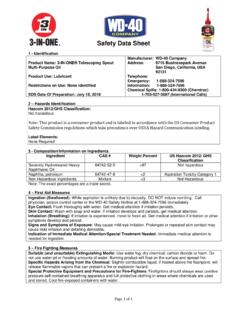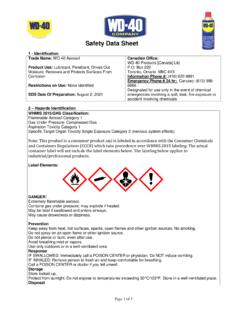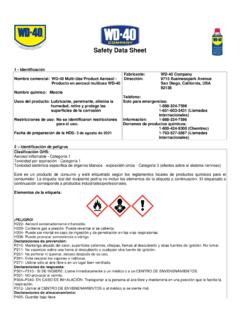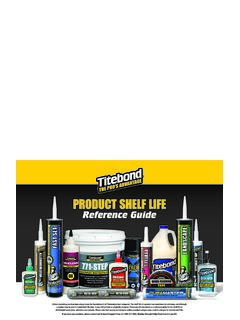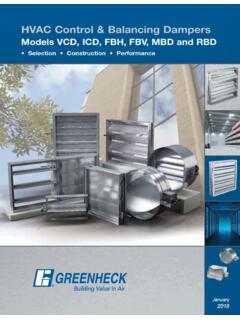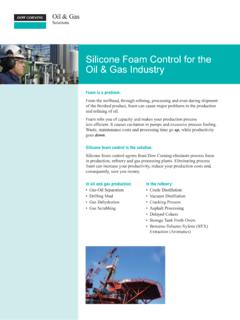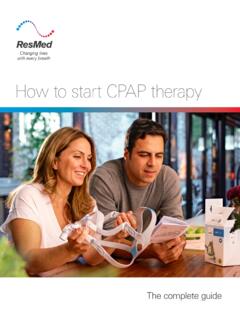Transcription of WD-40 Specialist Water Resistant Silicone Lubricant
1 Page 1 of 5 Safety Data Sheet 1 - Identification Product Name: WD-40 Specialist Silicone Quick Drying Product Use: Cleaner, Lubricant Restrictions on Use: None identified SDS Date Of Preparation: July 19, 2018 Manufacturer: WD-40 Company Address: 9715 Businesspark Avenue San Diego, California, USA 92131 Telephone: Emergency: 1-888-324-7596 Information: 1-888-324-7596 Chemical Spills: 1-800-424-9300 (Chemtrec) 1-703-527-3887 (International Calls) 2 Hazards Identification Hazcom 2012/GHS Classification: Flammable Aerosol Category 1 Gas Under Pressure: Compressed Gas Aspiration Toxicity Category 1 Note: This product is a consumer product and is labeled in accordance with the US Consumer Product Safety Commission regulations which take precedence over OSHA Hazard Communication labeling.
2 The actual container label will not include the label elements below. The labeling below applies to industrial/professional products. Label Elements: DANGER! Extremely Flammable Aerosol. Contains gas under pressure; may explode if heated. May be fatal if swallowed and enters airways. Prevention Keep away from heat, sparks, open flames, hot surfaces No smoking. Do not spray on an open flame or other ignition source. Pressurized container: Do not pierce or burn, even after use. Response IF SWALLOWED: Immediately call a POISON CENTER or physician. Do NOT induce vomiting. Storage Store locked up. Protect from sunlight. Do not expose to temperatures exceeding 50 C/122 F. Store in a well-ventilated place.
3 Disposal Dispose of contents and container in accordance with local and national regulations. 3 - Composition/Information on Ingredients Ingredient CAS # Weight Percent US Hazcom 2012/ GHS Classification LVP Petroleum Solvent 64742-47-8 60-80 Aspiration Toxicity Category 1 Poly(dimethylsiloxane) 63148-62-9 1-5 Not Hazardous Propellant (propane, n-butane) 74-98-6/106-97-8 10-30 Flammable Gas Category 1 Page 2 of 5 Gas Under Pressure, Compressed Gas Note: The exact percentages are a trade secret. 4 First Aid Measures Ingestion (Swallowed): Aspiration Hazard. DO NOT induce vomiting. Call physician, poison control center or the WD-40 Safety Hotline at 1-888-324-7596 immediately. Eye Contact: Flush thoroughly with Water .
4 Remove contact lenses if present after the first 5 minutes and continue flushing for several more minutes. Get medical attention if irritation persists. Skin Contact: Wash with soap and Water . If irritation develops and persists, get medical attention. Inhalation (Breathing): If irritation is experienced, move to fresh air. Get medical attention if irritation or other symptoms develop and persist. Signs and Symptoms of Exposure: Harmful or fatal is swallowed. If swallowed, may be aspirated and cause lung damage. May cause eye and respiratory irritation. Inhalation may cause coughing, headache and dizziness. Skin contact may cause drying of the skin. Indication of Immediate Medical Attention/Special Treatment Needed: Immediate medical attention is needed for ingestion.
5 5 Fire Fighting Measures Suitable (and unsuitable) Extinguishing Media: Use Water fog, dry chemical, carbon dioxide or foam . Do not use Water jet or flooding amounts of Water . Burning product will float on the surface and spread fire. Specific Hazards Arising from the Chemical: Extremely Flammable aerosol. Contents under pressure. Keep away from ignition sources and open flames. Exposure of containers to extreme heat and flames can cause them to rupture often with violent force. A vapor and air mixture can create an explosion hazard in confined spaces. Combustion will produce oxides of carbon, nitrogen and sulfur and hydrocarbons. Special Protective Equipment and Precautions for Fire-Fighters: Firefighters should always wear positive pressure self-contained breathing apparatus and full protective clothing.
6 Cool fire-exposed containers with Water . Use shielding to protect against bursting containers. 6 Accidental Release Measures Personal Precautions, Protective Equipment and Emergency Procedures: Wear appropriate protective clothing (see Section 8). Eliminate all sources of ignition and ventilate area. Methods and Materials for Containment/Cleanup: Leaking cans should be placed in a plastic bag or open pail until the pressure has dissipated. Contain and collect liquid with an inert absorbent and place in a container for disposal. Clean spill area thoroughly. Report spills to authorities as required. 7 Handling and Storage Precautions for Safe Handling: Avoid contact with eyes.
7 Avoid prolonged contact with skin. Avoid breathing vapors or aerosols. Use only with adequate ventilation. Keep away from heat, sparks, pilot lights, hot surfaces and open flames. Unplug electrical tools, motors and appliances before spraying or bringing the can near any source of electricity. Electricity can burn a hole in the can and cause contents to burst into flames. To avoid serious burn injury, do not let the can touch battery terminals, electrical connections on motors or appliances or any other source of electricity. Wash thoroughly with soap and Water after handling. Keep containers closed when not in use. Keep out of the reach of children. Do not puncture, crush or incinerate containers, even when empty.
8 Conditions for Safe Storage: Store in a cool, well-ventilated area, away from incompatible materials Do not store above 120 F or in direct sunlight. (NFPA 30B) Level 3 Aerosol. Store away from oxidizers. 8 Exposure Controls/Personal Protection Chemical Occupational Exposure Limits LVP Petroleum Solvent 1200 mg/m3 TWA (manufacturer recommended) Poly(dimethylsiloxane) None Established Propane 1000 ppm TWA OSHA PEL Page 3 of 5 n-Butane 1000 ppm STEL ACGIH TLV The Following Controls are Recommended for Normal Consumer Use of this Product Appropriate Engineering Controls: Use in a well-ventilated area. Personal Protection: Eye Protection: Avoid eye contact. Always spray away from your face. Skin Protection: Avoid prolonged skin contact.
9 Chemical Resistant gloves recommended for operations where skin contact is likely. Respiratory Protection: None needed for normal use with adequate ventilation. For Bulk Processing or Workplace Use the Following Controls are Recommended Appropriate Engineering Controls: Use adequate general and local exhaust ventilation to maintain exposure levels below that occupational exposure limits. Personal Protection: Eye Protection: Safety goggles recommended where eye contact is possible. Skin Protection: Wear chemical Resistant gloves. Respiratory Protection: None required if ventilation is adequate. If the occupational exposure limits are exceeded, wear a NIOSH approved respirator. Respirator selection and use should be based on contaminant type, form and concentration.
10 Follow OSHA , ANSI and good Industrial Hygiene practice. Work/Hygiene Practices: Wash with soap and Water after handling. 9 Physical and Chemical Properties Appearance: Colorless liquid Flammable Limits: (Solvent Portion) LEL: UEL: Odor: Mild petroleum odor Vapor Pressure: mmHg @25 C Odor Threshold: Not established Vapor Density: (Petroleum Solvent) pH: Not Applicable Relative Density: Not Determined Melting/Freezing Point Not established Solubilities: Insoluble in Water Boiling Point/Range: 221 C (430 F) Partition Coefficient; n-octanol/ Water : Not established Flash Point: <-30 C (-22 F) (CC ASTM D3828) Autoignition Temperature: Not established Evaporation Rate: Not established Decomposition Temperature: Not established Flammability (solid, gas) Flammable Aerosol Viscosity: Not established VOC: 20% Pour Point: Not established 10 Stability and Reactivity Reactivity: Not reactive under normal conditions Chemical Stability: Stable Possibility of Hazardous Reactions: May react with strong oxidizers generating heat.

